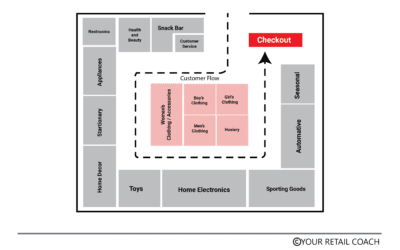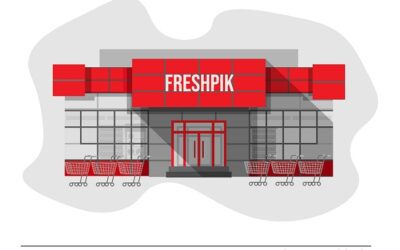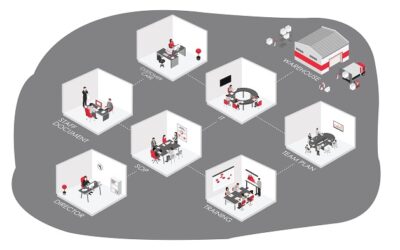Hypermarket Industry
So, What Exactly is a Hypermarket?
Oftentimes it is perplexing to grasp the true nature of the retailing format merely by the name assigned to a store. This occurrence is more common in local markets. Terms like ‘supermarket ’, ‘convenience store’ ‘departmental store’, or even ‘hypermarket’ are attached with store names. It is well known that these are all diverse formats of retailing. But it is also true that many retail brands exist in different retail formats. It is common among the big names in the retail space to operate in such multifaceted forms.
So, what exactly are hypermarkets? Hypermarkets are self-service, warehouse-like retail stores. Specific stores of Walmart or Decathlon fit into this description. The internal physical structure of a hypermarket looks like a warehouse but the visual appearance is like that of any supermarket or large grocery store for both small ticket retail selling as well as bulk selling.
But why is the concept of hypermarkets even there? Hypermarkets emerged to serve as one-stop stores with heavy price discounts for both individual and bulk-level purchasing. They are massive in size with extensive merchandising beating all other forms of retailing. The bulk availability of goods and heavy discounts serve as an incentive for small businesses at the local level to procure from hypermarkets.
Because of their enormous floor area requirements, it is common to find hypermarkets located on the city outskirts. This feature of hypermarkets is a deterrent for customers when it comes to routine and urgent purchases. A rational choice for them then is to buy from the local markets or even try online.
This is what hypermarkets are at an intended, accepted, and organised level.
A Peek into the Hypermarket Industry on the Global Scale
As an industry, hypermarkets will flourish albeit at a slow speed on a global scale. The industry is already competitive in developed countries. This will offset the growth propelled in the rest of the world. Speaking of the rest of the world, the growth rate will be higher in emerging regions like MENA, South East Asia, and South America. These are growing economies with rapidly rising urbanisation and mushrooming of SMEs. Successful global retail brands will seek to establish their own footing via direct investment or collaborate with well-networked domestic and regional retail brands.
To better comprehend the business of hypermarkets, let us examine a few renowned brands in the hypermarket space.
Walmart
Walmart is the largest hypermarket brand in the world. It is also the largest retail company in terms of revenue touching approximately USD 600 billion surpassing even the likes of Amazon. Today, Walmart is spread over a network of 10,500 stores and clubs in 19 countries in addition to its eCommerce channel. But that is not how things started for Walmart. In 1962, the first Walmart store was opened by Sam Walton in Arkansas, USA. However, it was in 1988 that Walmart opened its first Supercenter in Washington. The features of a supercenter are almost the same as that of a hypermarket.
Everything smart that Walmart did to explain its current dominance in the global hypermarket space cannot be covered within a few words but here are two examples. Walmart introduced computerised POS systems in its stores as early as the 80s. About the same time, Walmart had its operations supported by voice, data and video communication and that too through its own private satellite communication system in the United States. These kinds of decisions show how Walmart created the necessary systems required to augment massive operations like the ones involved in running hypermarkets.
Schwarz Gruppe
What brings Schwarz Gruppe into focus is its massive network of 13,500 stores worldwide surpassing even that of Walmart. The group’s revenue levelled heads with USD 141 billion in 2021. Owned by Schwarz Gruppe, Kaufland is a German hypermarket chain based out of Neckarsulm, Germany. Kaufland is one of the two food retailing brands of the Schwarz Gruppe. While Kaufland stores operate only in Europe, Lidl (the other one) has additional operations in America. Lidl stores came into existence in 1973 and Kaufland in 1984.
Some of the reasons that make Kaufland a unique brand are its extensive merchandising, competitive pricing, and customer orientation. It is recognised as a brand that focuses on quality, sustainability and eco-friendly options.
Target
Originated in 1902, Target is another big American retail brand. The year was 1995 and the place was Nebraska where the first SuperTarget store was opened. Currently, Target’s revenue clocks over USD 100 billion. The brand has a massive network of 1900+ stores in the United States. We could not confirm the presence of any Target store outside of the USA.
Target’s strategy to harness private-label brands makes its business model a highly effective one. Private-label brands help derive better margins. However, it does not work without ensuring quality and the presence of trust and loyalty on the umbrella brand in question.
A Big Customer Base Required
A big customer base is indispensable for the growth and survival of hypermarkets. A large customer base helps build reliable sales traffic and a dependable stream of revenue. Without sufficient sales and revenue, hypermarkets cannot thrive. A steady flow of customers and clients helps hypermarkets expand their merchandising portfolio, bring value-added services, and improve their infrastructure. This, in turn, helps build a strong transactional relationship with buyers.
Achieving economies of scale is another critical reason for hypermarkets to have a larger customer base. Bulk buying and selling enables hypermarket brands in price negotiations with suppliers and pass on the derived benefits to customers.
Lack of real estate in good locations
Almost anywhere in the world, finding commercial real estate space for establishing big businesses like hypermarkets or factories is slowly attaining the status of a dream coming true. Here we are not even talking about the rentals or leasing costs, the problem is even getting the space at a suitable location. The consumption of land resources for both residential and commercial purposes has swelled up like wildfire touching the borders of the countryside starting from urban boundaries. Without the support of local and regional factors and government initiatives to promote business, the only solution left to hypermarket brands is to make the best use of what is available to them.
Requires Big Space with High Rentals
Now coming to the rental factor, the available spaces come with a premium price tag. If there are no regulations, prices quoted could be just about anything. Given the demand-supply disparities in land resources in any modern location that suits the hypermarket business case, the buyers (retailers) are often at the receiving end. On the other hand, it is natural for real estate owners to accept the highest bidder. Even if such a space is acquired, there are business implications attached to it. Real estate is a long-term investment that is usually written off over time. The higher the investment is, the longer will be the time required to write it off. Where high rentals are involved, the operating costs swell and affect profitability.
No way to do it Small
There is no way to start and run a hypermarket on a small scale. Just in terms of floor area requirement, a hypermarket can range between 54,000 to 161,000 square feet. Inventory investment can run up to millions in value with merchandising mix extending in thousands. Starting a hypermarket business needs big investments, robust operations systems, and world-class standards in infrastructure and delivery of customer experience. And lack of or inability to bring any of these elements makes hypermarket business a distant subject for commoners. The role of governments and financial ecosystems is crucial when it comes to starting large-scale businesses. The business planning and setup-related affairs can be addressed with the help of hypermarket business consultants.
Influencing Consumer Behaviour
Conducive market statistics are no guarantee for footfall; hypermarkets have some specific reasons. Why would an individual customer shift their loyalty from a local grocery or departmental store to a newly launched hypermarket? Are they getting any extra benefits? Is that benefit big enough to make this shift? The same applies to small businesses. Unless they have a more compelling reason, they will not shift from their existing systems.
But there are also a couple of factors that work in favour of hypermarkets. One is the novelty of the idea itself. Hypermarkets are unlike what people might have seen or experienced earlier. Secondly, people can plan their purchases from hypermarkets if that can save them from the traffic woes and relish a peaceful shopping experience away from the cacophonies of the urban and drill of the mundane.
Why YRC as Consulting Partner for Hypermarket Business
YRC is a retail and eCommerce consulting firm with expertise in business management and growth solutions. With 11+ years in business and a budding global footprint, YRC has helped over 500 clients in 12 countries across 20+ retail verticals. The range of our services includes SOPs (BPMN 2.0), Market Research, Validation of Business Models, Franchise Consulting, and Process Automation. Our projects are handled by expert retail consultants with strong professional and project exposure. Our services and solutions are developed and implemented following sets of planned and proven principles and processes. In hypermarket business consulting, we offer assistance in business planning and implementation of business plans.
Market Research
We bring our 11+ years of experience to the table in developing curated market research plans based on the unique requirements and specifications of clients. In conducting hypermarket market research, a planned and methodical approach is followed that includes the use of cutting-edge digital applications. CTAs and recommendations are also presented for a better understanding of markets and to help clients make more effective planning and strategic decisions.
Locational Analysis
Businesses can make decisions on store location with a lot more certainty when the pros and cons of each option are available in comparable terms. Given the constraints in finding good sites and high rentals, we help clients make more informed decisions in the selection of locations in light of associated business implications. In hypermarket location analysis, our assessments are aimed at helping clients evaluate the right locations based on parameters relevant to their business vision and objectives.
Business Model Development and Validation
In hypermarket business model development, we help clients identify and map strong, unique, and sustainable value propositions. In hypermarket business model validation, we assess conceived business models to evaluate their strength and sustainability to endure in the prevailing business environment and suggest measures for improvisations. In both cases, our experts define the value chains mapping the best route to create and deliver the identified value propositions to the target segments.
Layout Planning
Layout planning is not a stand-alone decision. It influences and is influenced by other important factors like location, volume of space, visual merchandising, organogram, and marketing objectives. For example, a more distant location but with a bigger space may be selected to provide a bigger physical appearance to a store. This affects the layout planning of the store. In hypermarket layout planning, we present multiple layout options keeping in mind the unique constraints, requirements and specifications of clients.
Operations Planning and Adoption of Process Automation
Hypermarkets cannot thrive in a poor operations environment. The sheer volume of business is enough to justify it. That is why a majority of large-scale retailing enterprises rely on SOP-based operations planning and process automation solutions. SOP development & implementation assistance for business process and operations management is one of our frontline capabilities. We not only develop and help implement hypermarket SOPs but also assist in the identification and selection of hypermarket process automation solutions.
Financial and Commercial Planning
Since hypermarkets involve big investments and operating expenditures, the financial and commercial aspects of starting and running one cannot be treated under normal rules of prudence and expertise. Our 11+ years of experience working with retail enterprises of all sizes tell us that the stakes are way too big in the hypermarket business.
In financial and commercial planning for hypermarket businesses, we measure and present the business commercials required to take business ideas off the table and bring them into the realm of commercial possibility. Important areas covered in these assessments are demand forecasting, purchase planning, sales and revenue projections, analysis of CAPEX and OPEX requirements, estimated P/L statements, analysis of ROI and break-even periods, and other parameters as applicable.
To know more about our hypermarket business consulting services or if you want any business-related query addressed by one of our hypermarket business planning experts, drop us a message and we will be happy to reach out to you.
FAQs
What Type of Business is a Hypermarket?
Hypermarkets are warehouse-like, self-service massive retail stores. Specific branded stores of Walmart or Decathlon fit into this description. The internal structure of a hypermarket looks like a warehouse but the appearance is like that of any large supermarket or large grocery store for both small ticket and bulk selling.
How to Convert my Supermarket to a Hypermarket Business?
If it comes down to the comparison between the two, hypermarkets and supermarkets are vastly different concepts. For example, you can have a very large SUV but that still would not be a truck. For analogy, hypermarkets are like those trucks and all other retailing formats like grocery stores, departmental stores, or supermarkets are smaller vehicles.
If it is about converting a supermarket to a hypermarket, some of the important considerations to be critically examined are:
- Is the floor space available suitable enough for a hypermarket? (Also think in terms of extensive merchandising requirements)
- Is it possible to give massive discounts as hypermarkets do?
- Is the customer base (individuals and businesses) large enough to create the sales volume necessary to sustain the business commercials of a hypermarket?
- Are there suppliers/manufacturers who can provide inventory in large volumes at highly discounted rates?
· Are the necessary logistical infrastructure and services available to support the inventory appetite levels of a hypermarket?
Let’s Talk!
Related Blogs
Retail Store Layout Strategy: What to Consider and How to Plan
Why Store Layout Matters in Retail The layout of a retail store carries several internal and external business implications. Layout is an important physical aspect of branding efforts. It creates an opportunity to create the desired atmosphere in stores thereby...
Reliance Gourmet Supermarket – “Freshpik” Case Study
The fifth-largest and preferred retail destination globally, the Indian retail industry is one of the fastest-growing segments in the world. India is experiencing unprecedented growth with retail development taking place not just in major cities and metros, but also...
How to Organize & Grow Supermarket / Hypermarket
Already running a supermarket store and wondering how to scale it further? Are you contemplating what should be your next steps to accomplish your vision to organize and manage multiple stores? If this is what you are looking for, then you are in the right place. Your...





We work only for Visionaries.